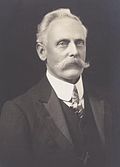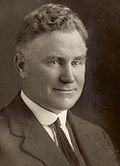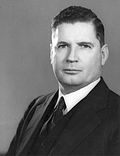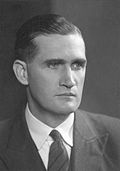- National Party of Australia
-
National Party of Australia 
Leader Warren Truss MP President John Tanner Deputy Leader Sen. Nigel Scullion Founded 1920 (As Country Party) Headquarters John McEwen House
7 National Circuit
BARTON ACT 2600Youth wing Young Nationals Ideology Conservatism,
Agrarianism[1][2]Political position Centre-right Official colours Green Yellow House of Representatives 6 / 150Senate 3 / 76Website http://www.nationals.org.au/ Politics of Australia
Political parties
ElectionsThe National Party of Australia is an Australian political party.
Traditionally representing graziers, farmers and rural voters generally, it began as the The Country Party, but adopted the name The National Country Party in 1975, changed to The National Party of Australia in 1982. The party is commonly referred to as The Nationals. Federally, in New South Wales, and to an extent Victoria, it has generally been the minor party in the traditional coalition with the Liberal Party of Australia in government. In Opposition it has worked in formal Coalition or separately, but generally in co-operation with the Liberal Party and it predecessor, the United Australia Party. It was the major coalition party in Queensland between 1957 and 2008, when it merged with the junior Queensland Division of the Liberal Party of Australia to form the Liberal National Party of Queensland – an organisation dominated by ex-Nationals.
The party's federal parliamentary leader since 3 December 2007, following the coalition's defeat at the 2007 federal election, is Warren Truss.[3]
Contents
History
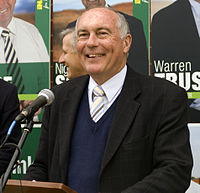 The current leader of the party in Federal Parliament, Warren Truss
The current leader of the party in Federal Parliament, Warren Truss William McWilliams, Country Party leader 1920–1921
William McWilliams, Country Party leader 1920–1921
According to historian B. D. Graham (1959), the graziers who operated the sheep ranches were politically conservative. They disliked the Labor party, which represented their workers, and feared that Labor governments would pass unfavorable legislation and listen to foreigners and Communists. The graziers were satisfied with the marketing organisation of their industry, opposed any change in land tenure and labor relations, and advocated lower tariffs, low freight rates, and low taxes. On the other hand, Graham reports, the small farmers, not the graziers, founded the Country party. The farmers advocated government intervention in the market through price support schemes and marketing pools. The graziers often supported the Country party politically and financially and made the Country party more conservative.[4]
The Country Party was formally founded in 1913 in Western Australia, and nationally in 1920 from a number of state-based parties such as the Victorian Farmers Union (VFU) and the Farmers and Settlers Party of New South Wales.[5]
The VFU won a seat in the House of Representatives in 1918, and at the 1919 federal election the state-based country parties won seats in New South Wales, Victoria and Western Australia. They also began to win seats in the state parliaments. In 1920 the Country Party was established as a national party led by William McWilliams from Tasmania. In his first speech as leader, McWilliams laid out the principles of the new party, stating "we crave no alliance, we spurn no support but we intend drastic action to secure closer attention to the needs of primary producers"[6] McWilliams was deposed as party leader in favour of Dr Earle Page in April 1921 following instances where McWilliams voted against the party line. McWilliams would later leave the Country Party to sit as an Independent.[6]
At the 1922 election, it won enough seats to deny the Nationalists an overall majority, and was the Nationalists' only realistic coalition partner. However, Page let it be known that his party would not serve under Hughes, and forced his resignation. Page then entered negotiations with the Nationalists' new leader, Stanley Bruce, for a coalition government. Page's terms were stiff—five seats in a Cabinet of 11, including the Treasurer portfolio and the second rank in the ministry for himself. Nonetheless, Bruce readily agreed, and the "Bruce-Page Ministry" was formed—thus beginning the tradition of the party's leader ranking second in Coalition cabinets.[5]
Page remained dominant in the party until 1939 and briefly served as an interim Prime Minister between the death of Joseph Lyons and the election of Robert Menzies as his successor, but Page's refusal to serve under Menzies led to his resignation as leader. The coalition was re-formed under Archie Cameron in 1940, and continued until October 1941 despite the election of Arthur Fadden as leader after the 1940 Election. Fadden was well regarded within conservative circles and proved to be a loyal deputy to Menzies in the difficult circumstances of 1941. When Menzies was forced to resign as Prime Minister, Fadden briefly replaced him as Prime Minister (despite the Country Party being the junior partner in the governing coalition). However, the two independents who had been propping up the government rejected Fadden's budget and brought the government down.[7]
Fadden stood down in favour of Labor leader John Curtin and continued as leader of the Opposition until the formation of the Liberal Party of Australia in 1945. After the 1946 election, Fadden resumed his political partnership with Robert Menzies, though still keen to assert the independence of his party. Indeed, in the lead up to the 1949 federal election, Fadden played a key role in the defeat of the Chifley Labor government, frequently making inflammatory claims about the "socialist" nature of the Labor Party, which Menzies could then "clarify" or repudiate as he saw fit, thus appearing more "moderate". In 1949 Arthur Fadden became Treasurer in the second Menzies government and remained so until his retirement in 1958. His successful partnership with Menzies was one of the elements that sustained the coalition, which remained in office until 1972 (Menzies himself retired in 1966).[7]
 John McEwen House, The National Party's headquarters in Canberra
John McEwen House, The National Party's headquarters in Canberra
Fadden's successor, Trade Minister John McEwen, took the then unusual step of declining to serve as Treasurer, believing he could better ensure that the interests of Australian primary producers were safeguarded. Accordingly McEwen personally supervised the signing of the first post-war trade treaty with Japan, new trade agreements with New Zealand and Britain, and Australia's first trade agreement with the USSR (1965). In addition to this he insisted on developing an all encompassing system of tariff protection that would encourage the development of those secondary industries that would "value add" Australia's primary produce. His success in this endeavour is sometimes dubbed "McEwenism". This was the period of the Country Party's greatest power, as was demonstrated in 1962 when McEwen was able to insist that Menzies sack a Liberal Minister who claimed that Britain's entry into the European Economic Community was unlikely to severely impact on the Australian economy as a whole.[8]
Menzies retired in 1966 and was succeeded by Harold Holt. McEwen thus became the longest-tenured member of the government, with the informal right to veto government policy. The most significant instance that McEwen exercised this came when Holt disappeared in December 1967. John Gorton became the new Liberal Prime Minister in January 1968. McEwen was sworn in as an interim Prime Minister pending the election of the new Liberal leader. Logically, the Liberals' deputy leader, William McMahon, should have succeeded Holt. However, McMahon was a staunch free-trader, and there were also rumors that he was homosexual. As a result, McEwen told the Liberals that he and his part would not serve under McMahon. McMahon stood down in favour of John Gorton. It would be only after McEwen announced his retirement that MacMahon would be able to successfully challenge Gorton for the Liberal leadership. McEwen's reputation for political toughness led to him being nicknamed "Black Jack" by his allies and enemies alike.[9]
At the state level, from 1957 to 1989, the Country Party under Frank Nicklin and Joh Bjelke-Petersen dominated governments in Queensland. It also took part in governments in New South Wales, Victoria, and Western Australia.[10]
However, successive electoral redistributions after 1964 indicated that the Country Party was losing ground electorally to the Liberals as the rural population declined, and the nature of some parliamentary seats on the urban/rural fringe changed. A proposed merger with the Democratic Labor Party (DLP) under the banner of "National Alliance" was rejected when it failed to find favour with voters at the 1974 state election.
Also in 1974, the Northern Territory members of the party joined with its Liberal party members to form the independent Country Liberal Party. This party continues to represent both parent parties in that territory. A separate party, the Joh-inspired NT Nationals, competed in the 1987 election with former Chief Minister Ian Tuxworth winning his seat of Barkly by a small margin. However, this splinter group were not endorsed by the national executive and soon disappeared from the political scene.[11]
Countrymindedness
"Countrymindedness" was a slogan that summed up the ideology of the Country Party from 1920 through the early 1970s.[12] It was an ideology that was physiocratic, populist, and decentralist; it fostered rural solidarity and justified demands for government subsidies. "Countrymindedness" grew out of the failure of the country areas to participate in the rapid economic and population expansions that occurred after 1890. The growth of the ideology into urban areas came as most country people migrated to jobs in the cities. Its decline was due mainly to the reduction of real and psychological differences between country and city brought about by the postwar expansion of the Australian urban population and to the increased affluence and technological changes that accompanied it.[13][14]
National Country Party, and National Party
In 1975 the Country Party changed its name to the National Country Party as part of a strategy to expand into urban areas. This had some success in Queensland under Joh Bjelke-Petersen, but nowhere else. In Western Australia, the party publicly walked out of the coalition agreement in Western Australia in May 1975, to return in 1976. However, the party split in two over the decision in late 1978, with a new National Party forming and becoming independent, holding three seats in the Western Australian lower house, while the National Country Party remained in coalition and also held three seats. They reconciled after the Burke Labor government came to power in 1983.
The 1980s were dominated by the feud between Bjelke-Petersen and the federal party leadership, which led to defeat at the 1987 federal election and the fall of the Nationals in Queensland in 1989. The Nationals experienced difficulties in the late 1990s from two fronts – firstly from the Liberal Party, who were winning seats on the basis that the Nationals were not seen to be a sufficiently separate party, and from the One Nation Party riding a swell of rural discontent with many of the policies such as multiculturalism and gun control embraced by all of the major parties. The rise of Labor in formerly safe National-held areas in rural Queensland, particularly on the coast, has been the biggest threat to the Queensland Nationals.
State parties
The continued success of the Australian Labor Party at a state level has put pressure on the Nationals' links with the Liberal Party, their traditional coalition partner. In most states, the Coalition agreement is not in force when the parties are in opposition, allowing the two parties greater freedom of action.
In Queensland the National Party has merged with the Liberal Party, forming the Liberal National Party in 2008. The Liberal National Party led by Lawrence Springborg went on to lose the March 2009 election to Anna Bligh's Australian Labor Party.
In South Australia, for the first time in the Nationals' history, in 2002 the single Nationals member in the House of Assembly entered the Rann Labor Government as a Minister forming an informal coalition between the two parties. Since the 2010 South Australian State election, the Nationals in South Australia have no representative in either the House of Assembly or the Upper House or at a Federal level.
For more details on this topic, see National Party of Western Australia.Western Australia's National Party chose to position itself in a similar way after an acrimonious co-habitation with the Liberals on the 2005 campaign trail. Unlike its New South Wales and Queensland counterparts, the WA party had decided to oppose Liberal candidates in the 2008 election. The party aimed to hold the balance of power in the state "as an independent conservative party" ready to negotiate with the Liberals or Labor to form a minority government. After the election, the Nationals negotiated an agreement to form a government with the Liberals and an independent MP, though not described as a "traditional coalition" due to the reduced cabinet collective responsibility of National cabinet members.[15]
Western Australia's one-vote-one-value reforms will cut the number of rural seats in the state assembly to reflect the rural population level: this, coupled with the Liberals' strength in country areas has put the Nationals under significant pressure.
The Nationals were stung in early 2006, when their only Victorian senator, Julian McGauran, defected to the Liberals and created a serious rift between the Nationals and the Liberals.[16] Several commentators believed that changing demographics and unfavourable preference deals would demolish the Nationals at the state election that year, but they went on to enjoy considerable success by winning two extra lower house seats. The Nationals are in a coalition with the Liberals at a State level in Victoria.
Political role
The Nationals see their main role as giving a voice to Australians who live outside the country's metropolitan areas.
Traditionally, the leader of the National Party serves as Deputy Prime Minister when the Coalition is in government. This tradition dates back to the creation of the office in 1968.
When the Liberal Prime Minister Harold Holt died in office[citation needed], his Country Party deputy John McEwen became Prime Minister for a period of weeks while the Liberal Party elected a new leader. In the Queensland state parliament, the National Party has historically been the stronger coalition partner numerically, and though the parties have merged, the majority of Members of the Queensland Parliament in the Liberal-National Party are former Nationals.[citation needed]
The National Party's support base and membership are closely associated with the agricultural community. Historically anti-union, the party has vacillated between state support for primary industries ("agrarian socialism") and free agricultural trade and has opposed tariff protection for Australia's manufacturing and service industries. This vacillation prompted those opposed to the policies of the Nationals to joke that its real aim was to "capitalise its gains and socialise its losses!". It is usually pro-mining, pro-development, and anti-environmentalist.
The Nationals hold a larger membership base than either the Liberal or Labor Parties, although in the larger eastern states its vote is in decline and its traditional supporters are turning instead to prominent independents such as Bob Katter, Tony Windsor and Peter Andren in Federal Parliament and similar independents in the Parliaments of New South Wales, Queensland and Victoria, many of whom are former members of the National Party. In fact at the 2004 Federal election, National Party candidates received fewer first preference votes than the Australian Greens. However, the situation in Western Australia and South Australia, where the party is more clearly differentiable from the Liberals, is quite different, with the Nationals narrowly missing out on winning a second seat in South Australia in 2006 and winning a safe Liberal seat in Western Australia in 2005.
Demographic changes are not helping, with fewer people living and employed on the land or in small towns, the continued growth of the larger provincial centres, and, in some cases, the arrival of left-leaning "city refugees" in rural areas. The Liberals have also gained support as the differences between the coalition partners on a federal level have become invisible. This was highlighted in January 2006, when Nationals Senator Julian McGauran defected to the Liberals, saying that there was "no longer any real distinguishing policy or philosophical difference".[17]
State and Territory
Lower House Seats
(And endorsed parties)NSW Parliament 18 / 93NT Parliament 11 / 25QLD Parliament 34 / 89VIC Parliament 10 / 88WA Parliament 5 / 59In Queensland, Nationals leader Lawrence Springborg advocated merger of the National and Liberal parties at a state level in order to present a more effective opposition to the Labor Party. Previously this plan had been dismissed by the Queensland branch of the Liberal party, but the idea received in-principle support from the Liberals. Federal leader Mark Vaile stated the Nationals will not merge with the Liberal Party at a federal level. The plan was opposed by key Queensland Senators Ron Boswell and Barnaby Joyce, and was scuttled in 2006. After suffering defeat in the 2006 Queensland poll, Lawrence Springborg was replaced by Jeff Seeney, who indicated he was not interested in merging with the Liberal Party until the issue is seriously raised at a Federal level.
Support for the Nationals in the 2006 Victorian state election was considerable with the party picking up two extra seats in the Lower House to maintain its total representation of 11 sitting members (two Upper House seats were lost, mostly due to a change from preferential to proportional representation). This success can be attributed to a more assertive National Party image (a differentation to that of the Liberals) and the growing popularity of state and federal Nationals identities such as Barnaby Joyce.
In September 2008, Barnaby Joyce replaced CLP Senator and Nationals deputy leader Nigel Scullion as leader of the Nationals in the Senate, and stated that his party in the upper house would no longer necessarily vote with their Liberal counterparts in the upper house, which opened up another possible avenue for the Rudd Labor Government to get legislation through.[18][19]
Liberal/National merger
Main article: Liberal-National party mergerMerger plans came to a head in May 2008, when the Queensland state Liberal Party gave an announcement not to wait for a federal blueprint but instead to merge immediately. The new party, the Liberal National Party, was founded in July 2008.
Historical electoral results
Federal results in the Lower House since 1919[20] Year 1919 1922 1925 1928 1929 1931 1934 1937 1940 1943 % 9.26 12.56 10.74 10.47 10.27 12.25 12.61 15.55 13.71 6.96 House Seats 11 of 75 14 of 75 14 of 75 13 of 75 10 of 75 16 of 75 14 of 74 16 of 74 14 of 74 7 of 74 Year 1946 1949 1951 1954 1955 1958 1961 1963 1966 1969 % 10.70 10.87 9.72 8.52 7.90 9.32 8.51 8.94 9.84 8.56 House Seats 11 of 74 19 of 121 17 of 121 17 of 121 18 of 122 19 of 122 17 of 122 20 of 122 21 of 124 20 of 125 Year 1972 1974 1975 1977 1980 1983 1984 1987 1990 1993 % 9.44 9.96 11.25 10.01 8.97 9.21 10.63 11.50 8.42 7.17 House Seats 20 of 125 21 of 127 23 of 127 19 of 124 20 of 125 17 of 125 21 of 148 19 of 147 14 of 148 16 of 148 Year 1996 1998 2001 2004 2007 2010 % 8.21 5.29 5.61 5.89 5.49 3.43 House Seats 19 of 148 16 of 148 13 of 150 12 of 150 10 of 150 6 of 150 Leaders
Leader of the National Party Term in office Notes William James McWilliams 1920–1921 Sir Earle Page 1921–1939 Prime Minister April 1939 Archie Cameron 1939–1940 Sir Arthur Fadden 1940–1958 Prime Minister August – October 1941 Sir John McEwen 1958–1971 Prime Minister December 1967 – January 1968
Deputy Prime Minister January 1968 – February 1971Doug Anthony 1971–1984 Deputy Prime Minister February 1971 – December 1972, November 1975 – March 1983 Ian Sinclair 1984–1989 Charles Blunt 1989–1990 Tim Fischer 1990–1999 Deputy Prime Minister March 1996 – July 1999 John Anderson 1999–2005 Deputy Prime Minister July 1999 – July 2005 Mark Vaile 2005–2007 Deputy Prime Minister July 2005 – November 2007 Warren Truss 2007–present Deputy Leaders
Shown in chronological order of leadership
Year Name Notes 1920 Edmund Jowett 1921 Henry Gregory 1922 William Fleming 1923 William Gibson 1929 Thomas Paterson 1937 Harold Thorby 1940 Arthur Fadden Later Prime Minister 1941 1941 vacant 1943 John McEwen Later Prime Minister 1967-68 1958 Charles Davidson 1964 Charles Adermann 1966 Doug Anthony Later Leader 1971 Ian Sinclair Later Leader 1984 Ralph Hunt 1987 Bruce Lloyd 1993 John Anderson Later Leader 1999 Mark Vaile Later Leader 2005 Warren Truss Later Leader 2007 Nigel Scullion* - * Senator
Current State Parliamentary Leaders
State Leader Notes NSW Andrew Stoner Deputy Premier of New South Wales since March 2011 NT Terry Mills Leader since 2008 1 QLD Jeff Seeney Leader since 2011 2 VIC Peter Ryan Deputy Premier of Victoria since December 2010 WA Brendon Grylls Leader Since 2005 1 In the Northern Territory, the National Party does not field candidates, although they endorse the Country Liberal Party as their preferred party in the Territory.
2 In Queensland, the National Party merged with the Liberal Party of Australia to form the Liberal National Party in 2008. Jeff Seeney is acting as parliamentary leader of the LNP and Leader of the Opposition, pending the preselection and election of Campbell Newman.
The National Party does not stand candidates in Tasmania or the Australian Capital Territory.
Past Premiers
Queensland
Premier Term Sir Frank Nicklin 12 August 1957 – 17 January 1968 Jack Pizzey 17 January 1968 – 31 July 1968 Sir Joh Bjelke-Petersen 8 August 1968 – 1 December 1987 Mike Ahern 1 December 1987 – 25 September 1989 Russell Cooper 25 September 1989 – 7 December 1989 Rob Borbidge 19 February 1996 – 20 June 1998 Victoria
Premier Term Sir John Allan 18 November 1924 – 20 May 1927 Sir Albert Dunstan 2 April 1935 – 14 September 1943, 18 September 1943 – 2 October 1945
John McDonald 27 June 1950 – 28 October 1952, 31 October 1952 – 17 December 1952
See also
- Young Nationals (Australia)
- Leader of the New South Wales National Party
Further reading
- Aitkin, Don. The country party in New South Wales (1972)
- Aitkin, Don. "'Countrymindedness': The Spread of an Idea," ACH: The Journal of the History of Culture in Australia, April 1985, Vol. 4, pp 34–41
- Davey, Paul. The Nationals: the Progressive, Country, and National Party in New South Wales 1919–2006 (2006)
- Davey, Paul. "Politics in the Blood - The Anthonys of Richmond" (2008)
- Davey, Paul. "Ninety Not Out - The Nationals 1920-2010" (2010)
- Davey, Paul. "The Country Party Prime Ministers - Their Trials and Tribulations" (2011)
- Duncan, C.J. "The demise of 'countrymindedness': New players or changing values in Australian rural politics?" Political Geography, Sep 1992, Vol. 11 Issue 5, pp 430–448
- Graham, B. D. "Graziers in Politics, 1917 To 1929," Historical Studies: Australia and New Zealand, 1959, Vol. 8 Issue 32, pp 383–391
- Leithner, Christian. "Rational Behaviour, Economic Conditions and the Australian Country Party, 1922–1937," Australian Journal of Political Science, July 1991, Vol. 26 Issue 2, pp 240–259
- Williams, John R. "The Organization of the Australian National Party," Australian Quarterly, 1969, Vol. 41 Issue 2, pp 41–51,
References
- ^ "What's in a name? Ask the Nationals". Melbourne: www.theage.com.au. 15 October 2003. http://www.theage.com.au/articles/2003/10/14/1065917410751.html?from=storyrhs. Retrieved 2010-04-30.
- ^ australian policy online[dead link]
- ^ "Truss wins Nationals leadership". Abc.net.au. 2007-12-03. http://www.abc.net.au/news/stories/2007/12/03/2107931.htm. Retrieved 2010-04-30.
- ^ B.D. Graham, "Graziers in Politics, 1917 To 1929," Historical Studies: Australia and New Zealand, 1959, Vol. 8 Issue 32, pp 383–391
- ^ a b Aitkin, (1972); Graham, (1959)
- ^ a b Neilson, W. (1986) 'McWilliams, William James (1856–1929)', Australian Dictionary of Biography, Volume 10, Melbourne University Press, Melbourne.
- ^ a b Davey (2006)
- ^ Davey (2005)
- ^ J. M. Barbalet, "Tri-Partism In Australia: The Role of the Australian Country Party," Politics (00323268), 1975, Vol. 10 Issue 1, pp. 1–11
- ^ Joseph Bindloss, Queensland (2002) p. 24
- ^ Jeremy Moon and Campbell Sharman, Australian politics and government (2003) p. 228
- ^ Rae Wear, "Countrymindedness Revisited," (Australian Political Science Association, 1990) online edition
- ^ Don Aitkin, "'Countrymindedness': The Spread of an Idea," ACH: The Journal of the History of Culture in Australia, April 1985, Vol. 4, pp. 34–41
- ^ C.J. Duncan, "The demise of 'countrymindedness': New players or changing values in Australian rural politics?" Political Geography, Sep 1992, Vol. 11 Issue 5, pp. 430–448
- ^ "Labor's clean sweep broken". News.com.au (Sydney). 2008-09-14. http://www.news.com.au/story/0,23599,24343802-1245,00.html. Retrieved 2008-09-14.[dead link]
- ^ Libs 'involved' in McGauran defection, The Age, 30 January 2006
- ^ "Senator McGauran quits Nationals – National". Melbourne: theage.com.au. 2006-01-23. http://www.theage.com.au/news/national/senator-mcgauran-quits-nationals/2006/01/23/1137864841636.html. Retrieved 2010-04-30.
- ^ "Nationals won't toe Libs' line: Joyce – SMH 18/9/2008". News.smh.com.au. 2008-09-18. http://news.smh.com.au/national/nationals-wont-toe-libs-line-joyce-20080918-4isw.html. Retrieved 2010-04-30.
- ^ Nicola Berkovic (2008-09-18). "Leader Barnaby Joyce still a maverick: The Australian 18/9/2008". Theaustralian.news.com.au. http://www.theaustralian.news.com.au/story/0,25197,24363515-5013404,00.html. Retrieved 2010-04-30.
- ^ "Australian elections, Australian election results, governments and parties in the Australian Government and Politics Database". Elections.uwa.edu.au. http://elections.uwa.edu.au/. Retrieved 2010-04-30.
External links
Politics of Australia Commonwealth Queen · Governor-General · Prime Minister · Cabinet · Executive Council · Ministry · Foreign relations
Parliament · Senate · House of Representatives · Opposition Leader
High Court · Lower courts
Constitution Act · Statute of Westminster · Australia Act
Federal elections State/territory governments State/Territorial elections Most
recentNSW (2011 election) · Vic (2010 election) · Qld (2009 election) · WA (2008 election) · SA (2010 election) · Tas (2010 election) · ACT (2008 election) · NT (2008 election)
NextLocal government Political parties Categories:- National Party of Australia
- Political parties established in 1922
- Conservative parties in Australia
- Agrarian parties
- 1922 establishments in Australia
Wikimedia Foundation. 2010.

